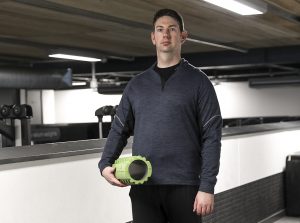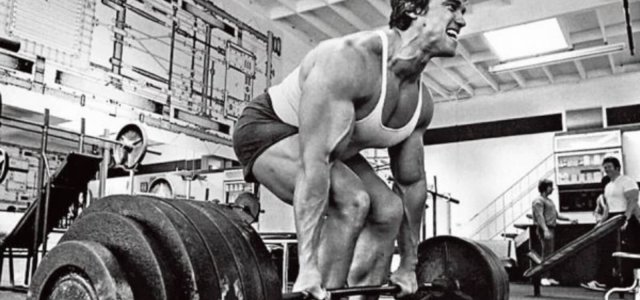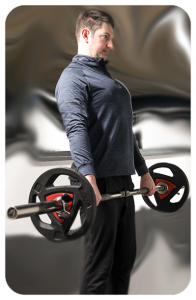
Mental Health in Lockdown 2.0
Mental Health in Lockdown 2.0 Richard Kelly 18th November 2020 I’m sure we could all sit here and discuss the

This week’s blog is purely self-indulgent from my perspective. But I believe that struggle, and overcoming challenge, are crucial components to future success. So here we are, how I worked my way up to being able to deadlift one hundred and forty kilos…
Strength has a very specific definition. It is defined as the ability to generate maximal force to move a load. From a gym perspective this means what is the maximum weight you can lift in a given exercise for one repetition. And, compared to your average person I’m fairly strong. In fact in most gyms I’ve been I’ve been one of the stronger people. Yet compared to most PTs I’m not strong. For most of my peers a 100kg bench press, and a 140kg squat and deadlift were not single rep numbers, they were weights to be repped out with. I know people who can bench 100kg for ten reps, or squat 140kg for fifteen.
I can’t do that. These are not the levels of strength I’m currently at. And the lift that always lagged the most, as I mentioned before, was my deadlift.
I’ve touched on my deadlift problems previously, and I’m not going into them here, but for the purposes of this there are certain significant achievements in deadlifting that are noteworthy. The first is clearly lifting body weight. Being able to lift body weight on a deadlift is seen as the first significant marker to being considered strong. Double body weight is seen as a big achievement, and is supposedly the first true marker of being strong, as men strength and conditioning coaches consider this level of strength to be the minimum for being considered strong. Anyone who can deadlift four times their body weight is considered in the gold standard of strength, as only a handful of people in the world have pulled four times their body weight.
In raw numbers the first significant number is a 60kg deadlift, as that signifies that you are on the road to strength. Why is this? Well you might have noticed the size of the twenty kilo plates are always the same size no matter what gym you go to. Well those plates are Olympic standard size, and when you can deadlift 60kg you can lift a bar at an Olympic standard height in a deadlift. 100kg is obviously the next tier up, as this would be two twenty kilo plates on each side. The golden number is 500kg, which is the world record deadlift. So lifting 400kg or more would put you into the elite bracket of deadlifters in the world.
A 60kg or 100kg deadlift is all well and good, but an experienced lifter won’t give you a second glance until you have three plates aside on the bar. The respectable number, the number that people start to take you seriously as a deadlifter is 140kg. 140kg is above body weight for virtually everyone, and for plenty of men it is in the ball-park of double body weight. It is perceived as a respectable weight to lift. And it is was the weight I was stuck just under for two years.
Until last month.
But let’s go back to the spring of 2017, because it was at this point that I switched to sumo deadlifts. Sumo deadlifts protect the back and tax the legs more, which is a body part that I’ve always been strong in. As previously stated, when I had deadlifted prior to this the lift had aggravated my back, and therefore by switching I was removing the focus from my back and onto my legs.
I started with just the bar and on blocks, and focused wholly on form. By using the blocks I started at a higher level and therefore exposed my back even less. It wasn’t long before I was pulling sixty, then eighty, then one hundred. By summer that year my deadlifts had cycled back into my routine twice a week, and my deadlifts were above one hundred kilos for five reps.
This progressed fairly consistently and by early autumn of that year I’d got myself up to one hundred and fifteen kilos for five reps. In theory 115kg for five is equivalent to a 130kg single rep. I remember there was one Friday where I’d completed my deadlifts in my programme and out of pure curiosity I wanted to see what my max was. I hadn’t tried to determine my max on a deadlift like this in a few years. So I took my time and moved up slowly, climbing from 120 upwards; I did 120, then 125, then 130, then 132.5, then 135, then 137.5. I put 140 on the bar. This was significant. As I mentioned this would have been a landmark weight to pull. I was already pleased that I had gone over the 130kg single rep number that I was expecting, but this would be a big deal.
So I set myself up, sat into position and tried to pull the bar from the ground. It moved, it came marginally off the ground, but ultimately I couldn’t lift it. No matter, I had over exceeded the number I was expecting, and 140kg would come soon enough, I thought.
How wrong I would be.
At the time I was following an undulating monthly training cycle. The workouts were largely the same, but the rep and goal was different. Strength was following by endurance, and this was followed by unilateral, before tempo, and then a return to strength training. That meant that the next chance I had to work on strength was in January 2018.
That was the month. I had five training weeks to hit the best numbers I could or the chance was gone and wouldn’t be back until April. My goal was to squat 140kg for five reps, bench press 90kg and deadlift 140kg, both for one. Going for all three in one month was not the wisest target, but judging by the progress I had made previously and the assumption that as a result of my training I had done in the other months I’d be more rounded, I felt that I would make progress. I was confident that I would be able to pull 140kg in a deadlift, and relatively confident about the 140kg squat. It was the bench press that I was really concerned about. That concern, however, was unfounded, as in week three of my five weeks I hit 93.75kg on the bench for one rep. I had achieved my goal target.
It was in the squat and deadlift where I was lagging. I have squatted 140kg for five reps before. But this was many years before, and I don’t believe the reps were that good, because the person I was squatting with I don’t believe judged it right. In this training process, back in January 2018, I was box squatting. Every rep was to ninety degree depth and touching the box, and therefore every rep was to the required standard. Why, then am I less concerned that my squat was lagging at this time? The difference for me was one of measuring. I can do a one rep max lift with a deadlift, because if it’s too heavy I can quit and pull out relatively safely. With a squat the weight is on my shoulders. If it’s too heavy I’m not coming back up and it’s hard to ditch the bar from that position. Therefore I was judging my squats against a five rep number, and my deadlift against either a five rep number or a raw one rep number. I needed 125kg for five to count as a 140kg one rep max.
In the squats I achieved that. I actually reached 127.5kg for five in the final week of January. But in the deadlift it was a different story. Because of my grip I couldn’t do more than 120kg for five reps. I could do 125kg for three, but I couldn’t get the additional two reps required. I therefore tried to get a single. And as I progressed through the final week I realised I was going to come out short. My progressions meant that I would end up at 137.5kg again. Or I could shoot in that final set for 140kg and see if I could do it.
I chose the latter.
Again I lined it up, and again I couldn’t get it much off the ground at all. And that was it, the chance appeared to have escaped me. By the time strength came around for me again my prep work in the previous months had not been ideal and I couldn’t do more than 120kg for five. I had gotten weaker over the period.
By the time my chance came in the autumn I had switched focus away from strength, and therefore didn’t have a chance to attempt to the work on the deadlift again until the start of 2019, where I moved gym and in the process spent January without a gym, doing runs and home workouts. That meant my strength phase in February was largely a recovery strength phase.
But by summer 2019 my strength had returned, and my chance at lifting 140kg was back in my sights. I once again attempted it… and I was once again stopped, this time at 135kg. On this occasion I actually determined that the sumo technique I was using was actually potentially the problem, as it lacked back recruitment. Therefore I started to conventional deadlift, something I hadn’t done in around two years by this point.
This switch is actually more complicated that you might think. Although they are in principle much the same, the differences between the two lifts means that there is a learning phase to go through. For the first few sessions I was back down in the 70 and 80kg range, as I re-familiarised myself with the movement. But it wasn’t long before I was back into the hundreds and then making my way back up in weight.
However, I was still behind where I had been in sumo, and my grip had still not improved in the way I’d hoped. Anything beyond around 120kg would cause problems for my grip if it was above three reps. The final change I made in the back end of 2019 was to switch to a switch grip method of lifting. That gave me a far stronger pull and meant my grip, which had been one of my limiting factors, was no longer a limitation.
And so, in January 2020 I went back into a strength phase once more. The goal here was not actually to deadlift 140kg. The goal was to improve my overall strength numbers back into the rough ballpark they had been in 2018, in order to speed up metabolism for the training I had planned in February and March of this year. And from that perspective what I did worked. And once again I did get close to 140kg. In the final deadlift session of January I pulled 135kg for one, and failed at 140kg. But I then went right down to 100kg and pulled that for a solid ten reps. When I did that I knew I was close to getting past 140kg in the near future. Unfortunately for me the training planned in February and March of 2020 took precedence, so my next chance would have been April or potentially May.
That all changed last week. Last week, due to a lack of sleep and severe workout time restrictions, I could not go through my scheduled workout routine. I only had half an hour, and so I decided to see what I was capable of. This time I didn’t mess around. I went up to 120kg pretty fast, then did 125kg and 130kg and 135kg, before deciding to skip over 137.5kg and go straight for 140kg.
The night previously I had watched a video where Eddie Hall, the current deadlift world record holder, explains his mental preparation for deadlifting. And in that moment I had realised that my mental focus on this lift was somewhat lacking. That was the difference to the lift I brought on that Tuesday morning.
This was a critical different. Before each lift I was spending a moment or two focusing on the lift, being present and ensuring I was breathing fully, before taking hold of the bar and moving into my set up position. To this lift I brought all my previous experience and adaptations; I was in conventional stance, I was using switch grip, and I had my set up perfect. This, added to the mental preparation meant I was able to pull past the point where my mental block had been, the point where the bar had appeared to no longer travel any higher, and allowed me to bring my muscle into play, so that I could hinge into fully standing.
I had done it.
After three years I had lifted 140kg.

Mental Health in Lockdown 2.0 Richard Kelly 18th November 2020 I’m sure we could all sit here and discuss the

A Carb is a Carb, just like a car is car, right? Richard Kelly 10th August 2020 There are a

Preview: Self Sabotage Richard Kelly 3rd August 2020 The following is a preview of today’s emailed blog being sent out

The fitness industry is a fraud Richard Kelly 23rd November 2020 The problem with my industry is that a great

Mental Health in Lockdown 2.0 Richard Kelly 18th November 2020 I’m sure we could all sit here and discuss the
You’ll receive all the latest news, posts and information regarding health and fitness.